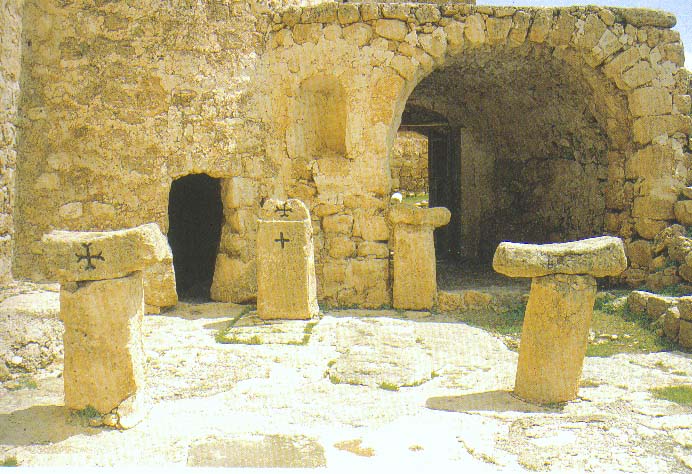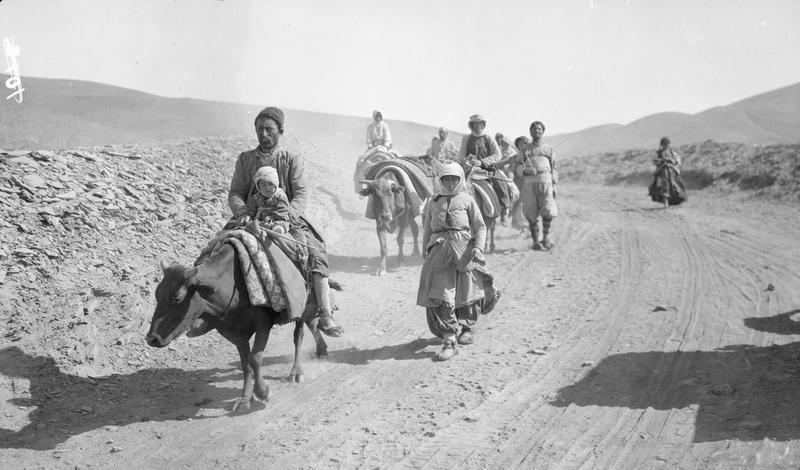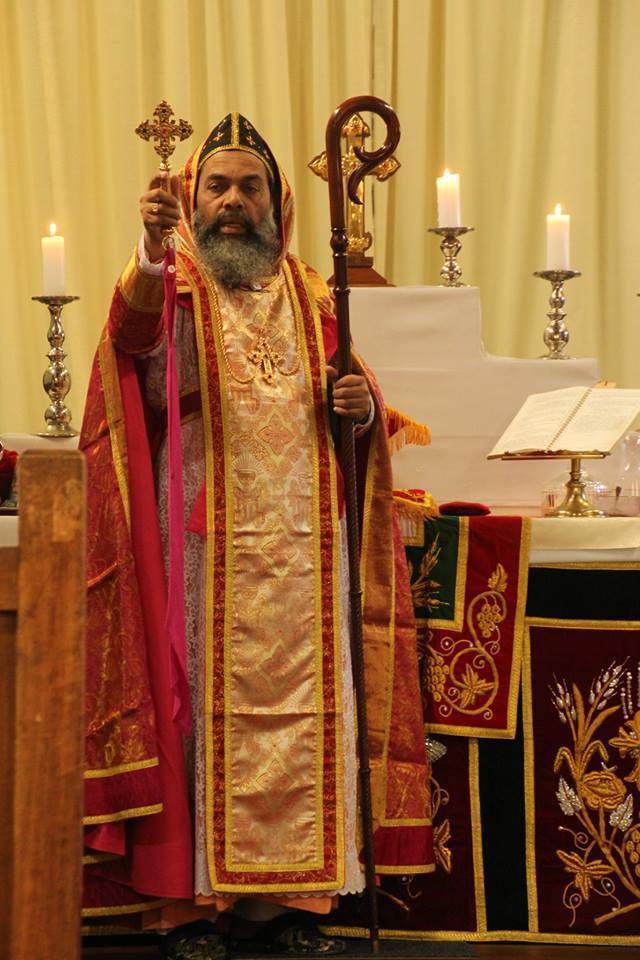|
Bağlarbaşı, Midyat
Bağlarbaşı (; ) is a neighbourhood in the municipality and district of Midyat, Mardin Province in Turkey. The village is populated by Syriacs and by Kurds of the Arnas tribe and had a population of 401 in 2021. It is located in the historic region of Tur Abdin. In the village, there is a church of Mar Basus and Mar Cyriacus. History A church was constructed at Urnus (today called Bağlarbaşı) by Emperor Anastasius I Dicorus () and designed by the architects Theodosius and Theodorus according to a manuscript dated to 1592, however the historian Andrew Palmer argues this was fabricated to add historicity. The Church of Mar Basus and Mar Cyriacus at Urnus, also called simply the Church of Mar Cyriacus, was probably constructed in the late seventh century AD. It was built by 761/762 ( AG 1072) at the latest as indicated by an inscription at the church commemorating the construction of a templon screen by the priest Elijah in that year. The monk-priest Yusuf (Joseph) of Urnus, ... [...More Info...] [...Related Items...] OR: [Wikipedia] [Google] [Baidu] |
Midyat
Midyat (, , , ) is a municipality and district of Mardin Province, Turkey. Its area is 1,241 km2, and its population is 120,069 (2022). In the modern era, the town is populated by Kurds, Mhallami Arabs and Assyrians. The old Estel neighborhood is about 80 to 85% Kurdish-populated. it was originally a Syriac Christian town made up of mostly Syriac Orthodox, Catholics, and Protestants. The spoken language of Midyat was until recently modern Aramaic (Surayt) and the town has throughout history been considered the capital of the Tur Abdin region, the heartland of Syriac Christianity. History Assyrian tablets from 9th century BC refer to Midyat as '' Matiate''. During a campaign in 879 BC, the Assyrian king Assurnasirpal II and his army marched through the city, staying for two nights. His successor, the Assyrian king Shalmaneser III did the same in 845 BC. The tablets also described how Assurnasirpal II erected a monument in the city, which remains to be found. The archae ... [...More Info...] [...Related Items...] OR: [Wikipedia] [Google] [Baidu] |
Patriarch Of Tur Abdin
From 1364 to 1816 the region of Tur Abdin constituted a distinct patriarchate within the Syriac Orthodox Church The Syriac Orthodox Church (), also informally known as the Jacobite Church, is an Oriental Orthodox Christian denomination, denomination that originates from the Church of Antioch. The church currently has around 4-5 million followers. The ch ..., with the following patriarchs: * Ignatius Saba of Salah (1364–1389) *Ignatius Isho' of Midhyat (1389–1418), died 1421 *Ignatius Mas'ud of Salah (1418–1420) *Ignatius Henoch of 'Ayn Ward (1421–1444) *Ignatius Qoma of Ba Sabrina (1444–1454) *Ignatius Isho' of Salah (1455–1460) *Ignatius 'Aziz (Philoxene) of Basila (1460–1482) *Ignatius Saba of Arbo (1482–1488) *Ignatius John Qofer of 'Ayn Ward (1489–1492) * Ignatius Mas'ud of Zaz (1492–1512) *Ignatius Isho' of Zaz (1515–1524) *Ignatius Simon of Hattakh (1524–1551) *Ignatius Jacob of Hisn (1551–1571) *Ignatius Sahdo of Midhyat (1584–1621) *Ignati ... [...More Info...] [...Related Items...] OR: [Wikipedia] [Google] [Baidu] |
Kurdish Settlements In Mardin Province
Kurdish may refer to: *Kurds or Kurdish people *Kurdish language **Northern Kurdish (Kurmanji) **Central Kurdish (Sorani) **Southern Kurdish ** Laki Kurdish *Kurdish alphabets *Kurdistan, the land of the Kurdish people which includes: **Southern Kurdistan **Eastern Kurdistan **Northern Kurdistan **Western Kurdistan See also * Kurd (other) *Kurdish literature *Kurdish music *Kurdish rugs *Kurdish cuisine *Kurdish culture *Kurdish nationalism Kurdish nationalism () is a nationalist political movement which asserts that Kurds are a nation and espouses the creation of an independent Kurdistan from Iran, Iraq, Syria, and Turkey. Early Kurdish nationalism had its roots in the Ottoman ... {{disambiguation Language and nationality disambiguation pages ... [...More Info...] [...Related Items...] OR: [Wikipedia] [Google] [Baidu] |
Neighbourhoods In Midyat District
A neighbourhood (Commonwealth English) or neighborhood (American English) is a geographically localized community within a larger town, city, suburb or rural area, sometimes consisting of a single street and the buildings lining it. Neighbourhoods are often social communities with considerable face-to-face interaction among members. Researchers have not agreed on an exact definition, but the following may serve as a starting point: "Neighbourhood is generally defined spatially as a specific geographic area and functionally as a set of social networks. Neighbourhoods, then, are the spatial units in which face-to-face social interactions occur—the personal settings and situations where residents seek to realise common values, socialise youth, and maintain effective social control." Preindustrial cities In the words of the urban scholar Lewis Mumford, "Neighborhoods, in some annoying, inchoate fashion exist wherever human beings congregate, in permanent family dwellings; and ma ... [...More Info...] [...Related Items...] OR: [Wikipedia] [Google] [Baidu] |
Germany
Germany, officially the Federal Republic of Germany, is a country in Central Europe. It lies between the Baltic Sea and the North Sea to the north and the Alps to the south. Its sixteen States of Germany, constituent states have a total population of over 84 million in an area of , making it the most populous member state of the European Union. It borders Denmark to the north, Poland and the Czech Republic to the east, Austria and Switzerland to the south, and France, Luxembourg, Belgium, and the Netherlands to the west. The Capital of Germany, nation's capital and List of cities in Germany by population, most populous city is Berlin and its main financial centre is Frankfurt; the largest urban area is the Ruhr. Settlement in the territory of modern Germany began in the Lower Paleolithic, with various tribes inhabiting it from the Neolithic onward, chiefly the Celts. Various Germanic peoples, Germanic tribes have inhabited the northern parts of modern Germany since classical ... [...More Info...] [...Related Items...] OR: [Wikipedia] [Google] [Baidu] |
Turoyo Language
Turoyo (), also referred to as Surayt (), or modern Suryoyo (), is a Central Neo-Aramaic language traditionally spoken by the Syriac Christian community in the Tur Abdin region located in southeastern Turkey and in northeastern Syria. Turoyo speakers are mostly adherents of the Syriac Orthodox Church. Originally spoken and exclusive to Tur Abdin, it is now majority spoken in the diaspora. It is classified as a vulnerable language. Most speakers use the Classical Syriac language for literature and worship. Its closest relatives are Mlaḥsô and western varieties of Northeastern Neo-Aramaic like Suret. Turoyo is not mutually intelligible with Western Neo-Aramaic, having been separated for over a thousand years. Etymology Term comes from the word ', meaning 'mountain', thus designating a specific Neo-Aramaic language of the mountain region of Tur Abdin in southeastern part of modern Turkey (hence ''Turabdinian'' Aramaic). Other, more general names for the language are ... [...More Info...] [...Related Items...] OR: [Wikipedia] [Google] [Baidu] |
Gülgöze, Midyat
Inwardo or Gülgöze () is a neighbourhood in the municipality and district of Midyat, Mardin Province, Turkey. Gülgöze is populated by Assyrians/Syriacs and had a population of 245 in 2024. In the village is the Syriac Orthodox Church of Mor Hadbşabo, which is in the care of a sole nun. Additionally, the village is home to the Churches of Mor Barsaumo and Kundel. Etymology The Syriac name for the village translates to "eye of the rose". History The village of Iwardo is situated on top of three hills, and is considered one of the oldest Assyrian/Syriac villages in the Tur Abdin region. The Church of Mor Barsaumo is located on a hill parallel to Aynwardo, carved into a rock structure and built on an old settlement in the village. The Church of Kundel is located five kilometers northwest of the village and is believed to have been built between the 6th and 8th century, although its origins are unclear. Both are not believed to have been used as a church space in a long time ... [...More Info...] [...Related Items...] OR: [Wikipedia] [Google] [Baidu] |
Barıştepe, Midyat
Barıştepe (in Turkish “Peace Hill”, , ) is a neighbourhood in the municipality and district of Midyat, Mardin Province in Turkey. The village is populated by Assyrians and by Kurds of the Arnas Kurdish tribe and had a population of 1,026 in 2021. In the village, there is the Syriac Orthodox ''Mor Yakup Monastery''. The construction of the monastery dates back to the 5th century AD during the Byzantine The Byzantine Empire, also known as the Eastern Roman Empire, was the continuation of the Roman Empire centred on Constantinople during late antiquity and the Middle Ages. Having survived the events that caused the fall of the Western Roman E ... era, and was later reconstructed in the 8th century. Right next to it there are the remains of an ancient temple. Retrieved 16 September 2023. ...
|
Sayfo
The Sayfo (, ), also known as the Seyfo or the Assyrian genocide, was the mass murder and deportation of Assyrian people, Assyrian/Syriac Christians in southeastern Anatolia and Persia's Azerbaijan (Iran), Azerbaijan province by Ottoman Army (1861–1922), Ottoman forces and some Kurdish tribes during World War I. The Assyrians were divided into mutually antagonistic churches, including the Syriac Orthodox Church, the Assyrian Church of the East, and the Chaldean Catholic Church. Before World War I, they largely lived in mountainous and remote areas of the Ottoman Empire and Persia, some of which were effectively Stateless society, stateless. The Ottoman Empire's nineteenth-century centralization efforts led to increased violence and danger for the Assyrians. Mass killing of Assyrian civilians began during the Persian campaign (World War I), Ottoman occupation of Azerbaijan from January to May 1915, during which massacres were committed by Ottoman forces and pro-Ottoman Kur ... [...More Info...] [...Related Items...] OR: [Wikipedia] [Google] [Baidu] |
Eastern Protestant Christianity
The term Eastern Protestant Christianity (also called Eastern Reformed Christianity as well as Oriental Protestant Christianity) encompasses a range of heterogeneous Protestant Christian denominations that developed outside of the Western world, from the latter half of the nineteenth century, and retain certain elements of Eastern Christianity. Some of these denominations came into existence when active Protestant churches adopted reformational variants of Eastern Orthodox Church, Eastern and Oriental Orthodox Church, Oriental Orthodox liturgy and worship, while others originated from Orthodox groups who were inspired by the teachings of Western Protestant missionaries and adopted Protestant beliefs and practices. Some Eastern Protestant Churches are in Communion (religion), communion with similar Western Protestant churches. However, there is no Full communion, universal communion between the various Eastern Protestant churches. This is due to the diverse polities, practices, lit ... [...More Info...] [...Related Items...] OR: [Wikipedia] [Google] [Baidu] |
Paris Peace Conference (1919–1920)
The Paris Peace Conference was a set of formal and informal diplomatic meetings in 1919 and 1920 after the end of World War I, in which the victorious Allies set the peace terms for the defeated Central Powers. Dominated by the leaders of Britain, France, the United States and Italy, the conference resulted in five treaties that rearranged the maps of Europe and parts of Asia, Africa and the Pacific Islands, and also imposed financial penalties. Germany, Austria-Hungary, Turkey and the other losing nations were not given a voice in the deliberations; this later gave rise to political resentments that lasted decades. The arrangements made by this conference are considered one of the greatest watersheds of 20th century geopolitical history which would lead to World War II. The conference involved diplomats from 32 countries and nationalities. Its major decisions were the creation of the League of Nations and the five peace treaties with the defeated states. Main arrangements ... [...More Info...] [...Related Items...] OR: [Wikipedia] [Google] [Baidu] |
Mor Hananyo Monastery
Mor Hananyo Monastery or Monastery of Saint Ananias (; ) is an important Syriac Orthodox Church, Syriac Orthodox monastery located five kilometers south east of Mardin, Turkey, in the Assyrian culture, Syriac cultural region known as Tur Abdin. Mor Hananyo Monastery was the headquarters of the Syriac Orthodox Church from until 1932. It is usually better known by its nickname, the Saffron Monastery (, ''''; , ') which is derived from the warm color of its stone. Assyrian culture, Syriac Orthodox culture was centered in two monasteries near Mardin (west of Tur Abdin), Mor Gabriel Monastery, Mor Gabriel and Deyrulzafaran. Name The Mor Hananyo Monastery has gone by different names throughout its existence. First called Mor Shelmon monastery, it was renamed Monastery of Saint Ananias or Mor Hananyo Monastery after Saint Ananias (Hananoy) in the seventh century. Legend has it that yellow flowers of the Crocus sativus, saffron corcus was mixed into the Mortar (masonry), mortar during ... [...More Info...] [...Related Items...] OR: [Wikipedia] [Google] [Baidu] |




